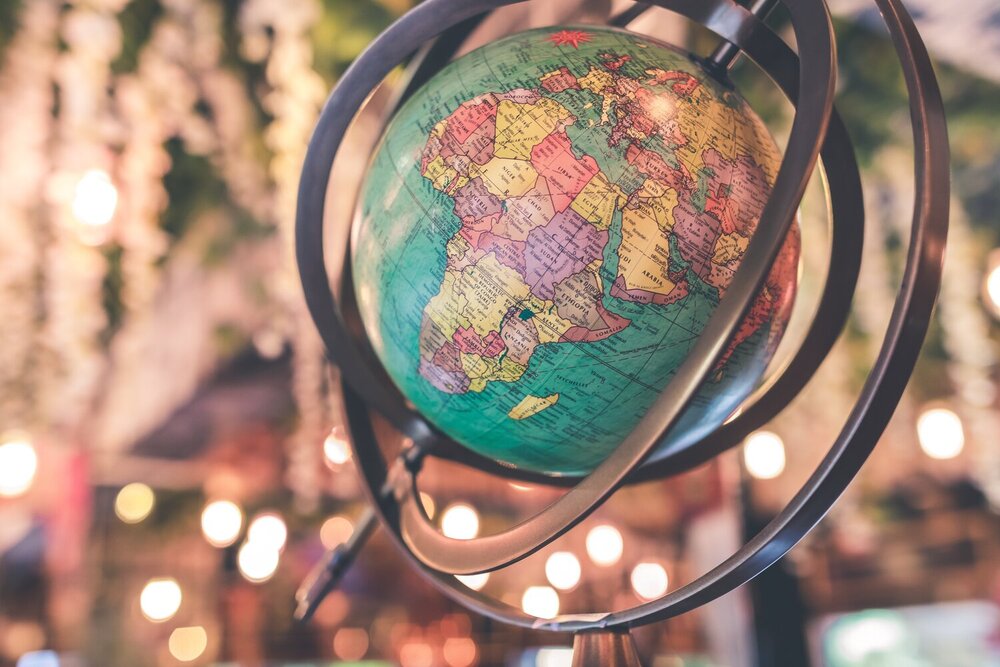Continents & Languages
Learn about Languages around the Globe!

Which Continent, Which Language?
Here is an overview of languages in different continents or regions of our globe.
European Languages
European languages are spoken in many parts of the world, especially in Europe, Africa and the Americas. They belong to the Indo-European languages and comprise three major language families: Romance, Germanic, and Slavic. A fourth one, the Celtic language family nowadays only accounts for Irish, Welsh, Scottish Gaelic and Breton, whereas in the past it was spread out over vast areas of Europe.
The languages with the highest diffusion are English and Spanish, followed by Portuguese, Russian, German, French and Italian. They include more than 50 additional languages, such as Finnish, Danish, Dutch, Czech, Catalan, Greek, or Romanian.
South Asian Languages
South Asian languages are spoken in one of the most populated regions of the world. This region with its fast-growing industries is gaining increasing importance in the global marketplace.
Hindi (400-500 million, India)
Bengali (250 million, Bangladesh, India)
Punjabi (120 million, Pakistan, India)
Marathi (85 million, India)
Telugu (83 million, India)
Tamil (75 million, India, Sri Lanka)
Urdu (70 million, Pakistan, India)
Gujarati (60 million, India)
Kannada (45 million, India)
Malayalam (40 million, India)
Sinhalese/Sinhala (20 million, Sri Lanka)

There are also numerous so-called minor languages, especially in India, which is the linguistically most abundant country, where more than 400 languages are spoken, some of them by millions of people. Most of the languages in Northern and Central India developed from the classic Sanskrit, which belongs to Indo-European language family.
For any company doing business in South Asia it should be worthwhile to target the consumers of those countries in their native tongues!
Major East Asian Languages
Numerous languages are spoken in East Asia. They belong to distinct families and some of them are unrelated to any other major language. Chinese, with its many dialects, is by far the most widely spoken language in East Asia, with about 1.3 billion native speakers. Other East Asian languages with high diffusion by approximate number of native speakers are Bahasa Indonesia/Javanese/Sundanese (160 to 180 million), Japanese (125 million), Korean (75 million), Vietnamese (70 million), Thai (40 to 50 million), Malay (30 to 40 million), and Tagalog (30 million).
Minor East Asian Languages
East Asia is an area of exceptional linguistic diversity. Beside the major languages, such as Chinese, Indonesian, Japanese, Korean, Vietnamese, Thai, Malay, and Tagalog, there are numerous so-called minor languages. Some of these languages are actually spoken by a great number of people in countries with growing economies and attractive markets. For any company doing business in East Asia it should be worthwhile to target the consumers of those countries in their native tongues.

Cambodian/Khmer (Cambodia, Thailand, Vietnam)
Nepali (Nepal, Bhutan),
Mongolian (Mongolia, China)
Tibetan (Tibet, China, Nepal)
Taiwanese (Taiwan)
Lao/Laotian (Laos, Thailand
Yao/Mien, Miao/Hmong (Laos)
Burmese (Myanmar)
Ilocano, Cebuano (Philippines)
Madurese (Indonesia)
Western and Central Asian Languages
Here are the major Western and Central Asian languages, with the approximate number of native speakers:
Arabic and its variations (240 million in the Middle East, 160 million in Africa)
Farsi (Persian) (70–90 million), and Tajiks (8.5 million) whose language is similar to Farsi.
Turkish (78 million) and Uzbek (28 million), Kazakh (22 million), Turkmen (7 million), Kyrgyz (5 million) which belong to the Turkic language family and resemble Turkish.
Pashto (50 million)
Kurdish (30 million)
Azerbaijani (23 million)
Dari (23 million)
Hebrew (7 million, 9 million worldwide),
Armenian (7 million)
Georgian (4 million)
Some of Western and Central Asian countries are faced with political instability, economic challenges, and profound cultural changes which makes communication in their languages especially important.

Languages of the Americas
While it may be debatable, if American English, Canadian French, Brazilian Portuguese, English Creoles, French Creoles, and Portuguese Creoles should be considered European languages or languages of the Americas, we are focusing here on the major languages that were and still are spoken by the indigenous people of the Americas.
Sadly, there is a decreasing trend of indigenous language use in all countries, especially in the US and Canada. Here are the major indigenous languages and where they are spoken.

United States: Navajo, Dakota, Lakota, Cherokee, Apache, Hopi, Yupik, and Inuit
Canada: Cree, Ojibway, and Inuit
Mexico: Nahuatl, Mixtec, and Zapotec
Mexico, Guatemala, Belize, Honduras, El Salvador: Maya
Peru, Brazil, Bolivia, Argentina, Chile, Ecuador and Colombia: Quechua
Bolivia: Aymara
Paraguay and adjacent areas: Guaraní
Colombia, Venezuela: Wayuu
You may never have a need for those languages, but if you do, USA TRANSLATIONS is here to help you!
African Languages
Some European languages, like English and French, are widespread in Africa as a lingua franca. However, authentic African languages are gaining more, and more ground, as the African countries have been in the process of leaving their colonial past behind and finding their own identity. You may prefer to tune in to that trend and address your target audience in those languages. It makes sense to not only be seen and heard by people with a European background but by all the people who speak the language that is commonly used in a particular country.
Africa is linguistically a remarkably diverse continent with many language families. Here are the major African languages with the approximate number of native speakers:
Swahili (more than 15 million, with about 82 million second language speakers)
Hausa (35 million)
Oromo (32 million)
Yoruba (28 million)
Igbo (27 million)
Fulani (25 million)
Amharic (22 million)
Malagasy (18 million)
Somali (17 million)
Berber (16 million)
Zulu (12 million)
Akan (11 million)
By most accounts, Africa’s economic growth makes it the continent of the future, with the African languages becoming essential for effective communication.

